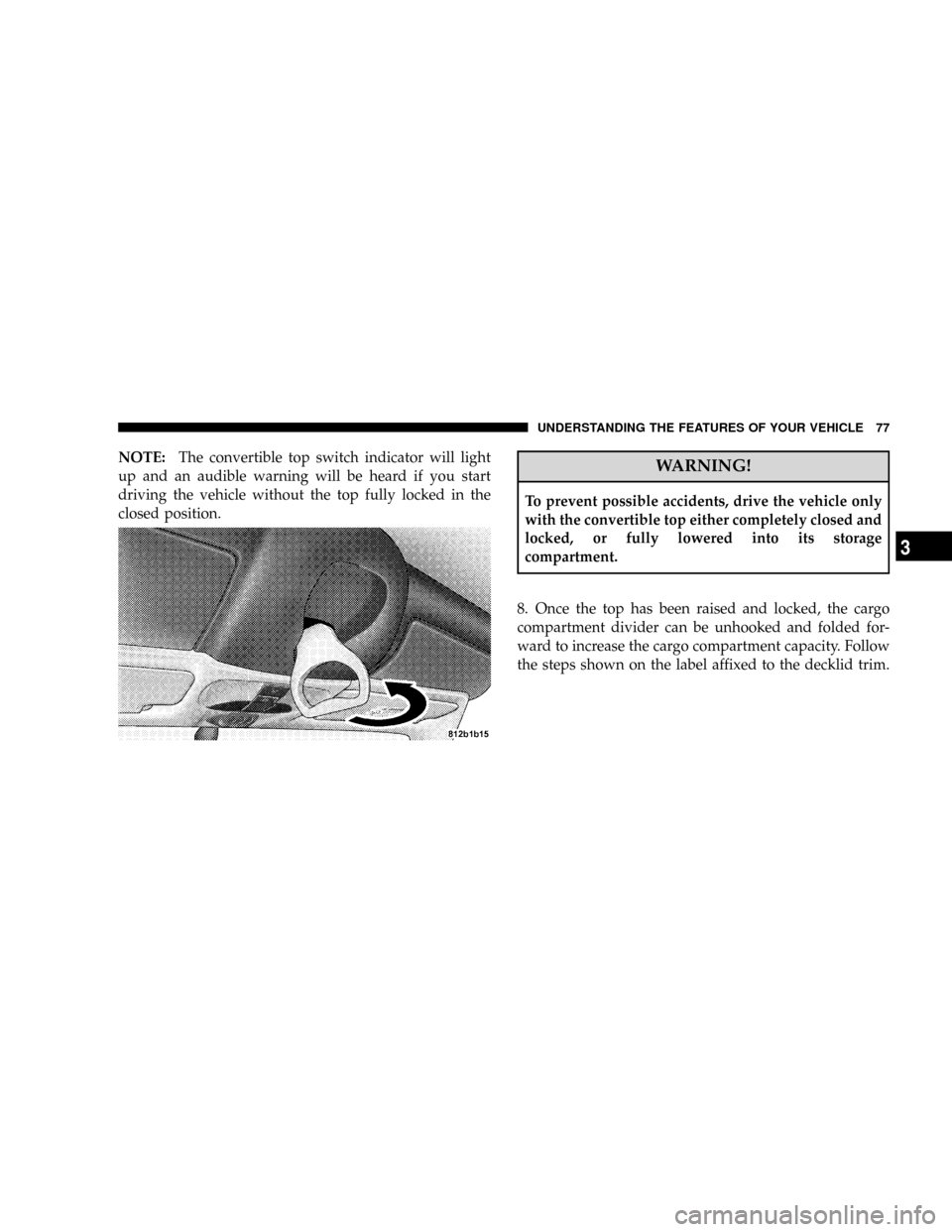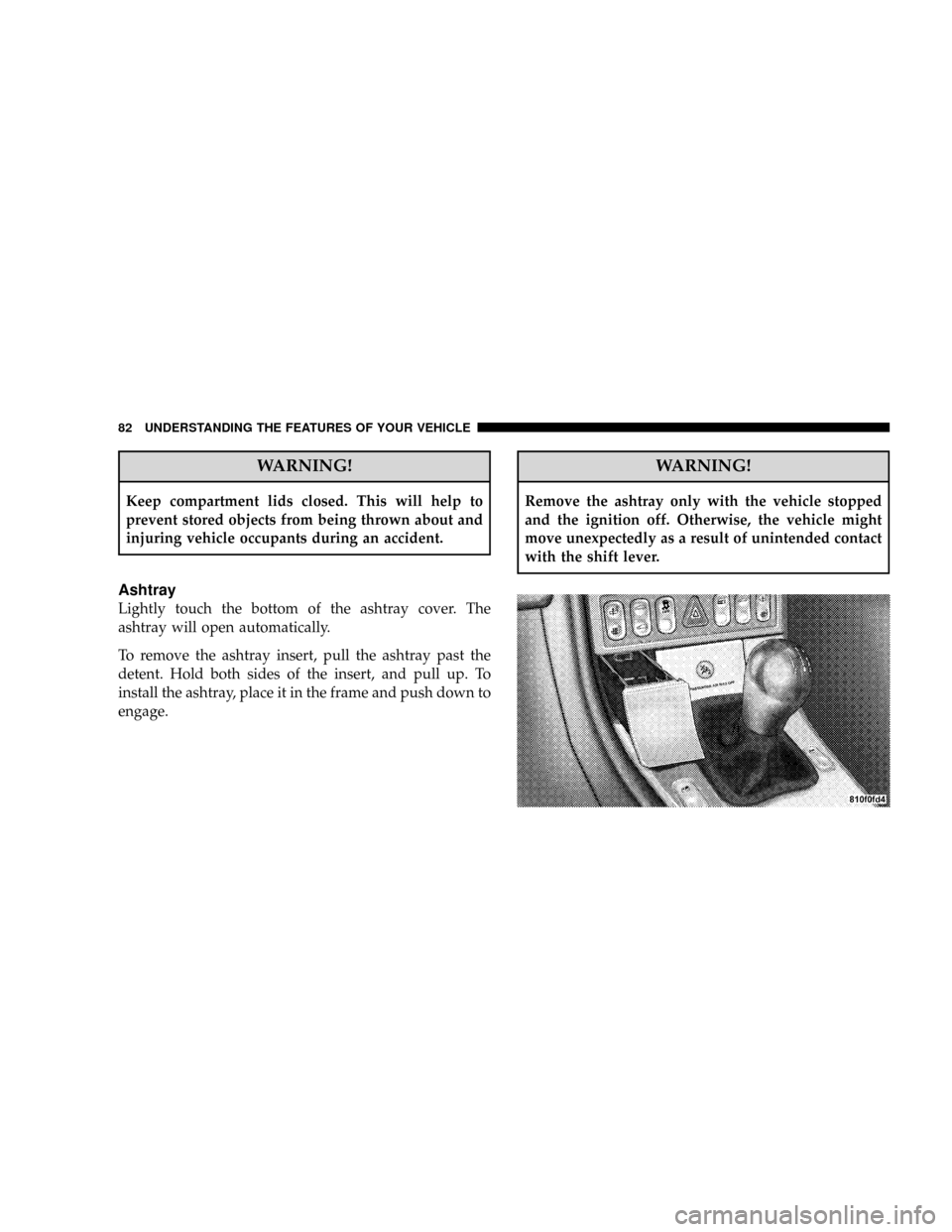2008 CHRYSLER CROSSFIRE warning light
[x] Cancel search: warning lightPage 39 of 358

WARNING!
²Relying on the airbags alone could lead to more
severe injuries in a collision. The airbags work
with your seat belt to restrain you properly. In
some collisions the airbags won't deploy at all.
Always wear your seat belts even though you have
airbags.
²Being too close to the steering wheel or instrument
panel during airbag deployment could cause seri-
ous injury.
²Airbags need room to inflate. Sit back, comfort-
ably extending your arms to reach the steering
wheel or instrument panel.
²The side airbags also need room to inflate. Do not
lean against the door. Sit upright in the center of
the seat.
Airbag System Components
The airbag system consists of the following:
²Occupant Restraint Controller
²Airbag Warning Light
²Driver and passenger frontal airbag/inflator units
²Driver and passenger side airbag/inflator units
²Driver and Passenger Inflatable Knee Blocker
²Driver and Front Passenger Seat Belt Pretensioners
²Side impact sensors
²Front Passenger Seat Occupant Classification System
(OCS)
How the Front Airbag System Works
²
TheOccupant Restraint Controller (ORC)determines
if a frontal collision is severe enough to require the
THINGS TO KNOW BEFORE STARTING YOUR VEHICLE 37
2
Page 40 of 358

airbags to inflate. Based on the level of collision
severity, the front control module determines the
proper rate of inflation. The front airbag inflators are
designed to provide different rates of airbag inflation
from direction provided by the ORC. The ORC may
modify the rate of inflation based on the occupant size
provided by the Occupant Classification Module. The
ORC will not detect roll overs. The ORC monitors the
readiness of the electronic parts of the system when-
ever the ignition switch is in the START or RUN
positions. If the key is in the OFF position, in the ACC
position, or not in the ignition, the airbags are not on
and will not inflate.
Also, the ORC turns on the AIRBAG warning light
(located in the instrument cluster) and Passenger
Airbag Disable (PAD) indicator light (located in the
center console) for 4 seconds for a self-check when theignition is first turned on. After the self-check, the
AIRBAG warning light will turn off. The PAD indica-
tor light will function normally (Refer to ªPassenger
Airbag Disable (PAD) Indicator Lightº in this section).
If the ORC detects a malfunction in any part of the
system, it turns on the AIRBAG warning light either
momentarily or continuously.
WARNING!
Ignoring the AIRBAG light in your instrument panel
could mean you won't have the airbags to protect you
in a collision. If the light does not come on, stays on
after you start the vehicle, or if it comes on as you
drive, have the airbag system checked right away.
38 THINGS TO KNOW BEFORE STARTING YOUR VEHICLE
Page 45 of 358

²The operational readiness of the side airbag system is
verified by the airbag indicator light in the instrument
cluster when turning the key in the ignition switch to
the ON/RUN position. If no fault is detected, the light
will go out after approximately four seconds. After the
light goes out, the system continues to monitor the
components and circuitry of the airbag system and
will indicate a malfunction by coming on again. If the
light does not come on at all, or if it fails to go out after
the four seconds, or if it comes on thereafter, a mal-
function in the system has been detected. See your
authorized dealer for service.WARNING!
²The door mounted side airbag deploys with consid-
erable force. Being too close to the door panel during
airbag deployment could cause serious injury or
death.
²All occupants must be in the appropriate restraint for
their size and age, especially children 12 and under.
²To help avoid the potential for serious injury and
death should the side airbag be activated, please
follow these guidelines:
1. Occupants, especially children, should never lean
against the door in the area where the side airbag
inflates;
2. Occupants need to sit upright in the center of the seat
to give the side airbag room to inflate;
3. Always use the appropriate restraint for the occupant
and ensure it is properly used.
THINGS TO KNOW BEFORE STARTING YOUR VEHICLE 43
2
Page 46 of 358

How the Occupant Classification System (OCS)
System Works
The Occupant Classification System (OCS) will classify
an occupant in the front passenger seat into a size
category based on sensor readings from within the seat
cushion. Occupants should try to remain in a normally
seated position. If the occupant's weight is transferred to
another object in the vehicle (i.e. feet on the dashboard),
the OCS may not be able to properly approximate
occupant size. Furthermore, the occupant size may ap-
pear to increase or decrease due to objects hanging on the
seat, other passengers pushing on the seat, or objects
lodged underneath the seat. If there is a rapid change in
temperature or humidity, the OCS may not be able to
properly approximate occupant size. If your seat includ-
ing your trim cover and cushion needs to be serviced in
any way, take the vehicle to your authorized dealer. Only
manufacturer approved seat accessories may be used. If
there is a fault present in the system, the AIRBAGwarning light will light indicating that you should take
the vehicle to an authorized dealer. In the presence of an
occupant in the passenger seat, if both the Passenger
Airbag Disable (PAD) indicator light (located in the
center console) and AIRBAG warning light (located in
the instrument cluster) are illuminated the airbag will be
disabled. The Occupant Restraint Controller (ORC) will
not allow front airbag deployment in the event of a
collision for occupants classified into the empty or child
size categories. The PAD indicator light will illuminate
indicating that the Passenger Airbag is OFF when the
OCS has determined that the occupant size category is a
child. Also, when the seat is empty or an object that
weighs less than a predetermined threshold is placed on
the seat, the light will remain OFF. (The PAD indicator
light is an amber light located in the center console.) For
almost all sizes of properly seated adults, the passenger
frontal airbag will be enabled in the event of a collision.
For small teenagers and some small adults, depending on
44 THINGS TO KNOW BEFORE STARTING YOUR VEHICLE
Page 48 of 358

²Do not replace the seat cover with an aftermarket seat
cover.
²Do not add a secondary seat cover other than those
approved by DaimlerChrysler/Mopart.
²At no time should any supplemental restraint system
(SRS) component or SRS related component or fas-
tener be modified or replaced with any part except
those which are approved by DaimlerChrysler/
Mopart.
How the Occupant Classification Module (OCM)
Works
The Occupant Classification Module (OCM) is located
beneath the passenger seat. The OCM classifies the
occupant into one of three size categories based on the
input from the Bladder Assembly and a Belt Tension
Sensor. The size categories include empty, child, and
adult. The OCM sends the Occupant Classification to theORC to determine if a front passenger airbag is allowed.
If a fault is present, the AIRBAG warning light is illumi-
nated.
How the Passenger Airbag Disabled (PAD)
Indicator Light Works
The Passenger Airbag Disabled (PAD) Indicator Light
indicates to the driver and passenger when the airbag is
turned OFF. In the presence of a properly seated occu-
pant, when the PAD indicator light is illuminated, the
airbag is OFF. Also, when the Occupant Classification
System detects either an empty seat or a weight less than
the predetermined threshold, the ORC will not illuminate
the PAD indicator light even though the airbag is turned
OFF.
How the Belt Tension Sensor (BTS) Works
The Belt Tension Sensor (BTS) is located at the outboard
passenger lap belt anchor. The BTS creates a signal based
on outboard lap belt tension. This signal is sent to the
46 THINGS TO KNOW BEFORE STARTING YOUR VEHICLE
Page 52 of 358

To Turn On the Passenger Airbag:
²Place the ignition key in the on/off switch, turn the
key counterclockwise, and remove the key from the
switch. This will turn on the passenger airbag. The
Passenger Airbag Off light on the console will turn off,
or will not be illuminated when the ignition is turned
to the ON position.
WARNING!
The airbag may malfunction and serious injury could
result if key is left in the airbag shut off switch.
Always remove the key.
Maintaining Your Airbag System
WARNING!
²Unapproved modifications or service procedures to
the front passenger seat assembly, its related compo-
nents, or seat cover may inadvertently change the
airbag deployment in case of a frontal crash. This
could result in death or serious injury to the front seat
passenger if the vehicle is involved in an accident. A
modified vehicle may not comply with required Fed-
eral Motor Vehicle Safety Standards (FMVSS).
²You need proper knee impact protection in a collision.
Do not mount or locate any aftermarket equipment on
or behind the knee impact blocker.
²You can be injured if you are too close to either airbag
cover when the airbags inflate. It is dangerous to try
to repair any part of the airbag system yourself. Don't
try to repair the airbag system. Be sure to tell anyone
who works on your vehicle that it has airbags.
50 THINGS TO KNOW BEFORE STARTING YOUR VEHICLE
Page 79 of 358

NOTE:The convertible top switch indicator will light
up and an audible warning will be heard if you start
driving the vehicle without the top fully locked in the
closed position.WARNING!
To prevent possible accidents, drive the vehicle only
with the convertible top either completely closed and
locked, or fully lowered into its storage
compartment.
8. Once the top has been raised and locked, the cargo
compartment divider can be unhooked and folded for-
ward to increase the cargo compartment capacity. Follow
the steps shown on the label affixed to the decklid trim.
UNDERSTANDING THE FEATURES OF YOUR VEHICLE 77
3
Page 84 of 358

WARNING!
Keep compartment lids closed. This will help to
prevent stored objects from being thrown about and
injuring vehicle occupants during an accident.
Ashtray
Lightly touch the bottom of the ashtray cover. The
ashtray will open automatically.
To remove the ashtray insert, pull the ashtray past the
detent. Hold both sides of the insert, and pull up. To
install the ashtray, place it in the frame and push down to
engage.
WARNING!
Remove the ashtray only with the vehicle stopped
and the ignition off. Otherwise, the vehicle might
move unexpectedly as a result of unintended contact
with the shift lever.
82 UNDERSTANDING THE FEATURES OF YOUR VEHICLE